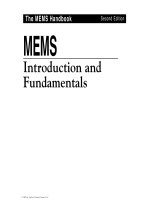The frontal sinus second edition
Bạn đang xem bản rút gọn của tài liệu. Xem và tải ngay bản đầy đủ của tài liệu tại đây (24.35 MB, 572 trang )
Stilianos E. Kountakis
Brent A. Senior
Wolfgang Draf Editors
The Frontal Sinus
Second Edition
123
The Frontal Sinus
Stilianos E. Kountakis • Brent A. Senior
Wolfgang Draf
Editors
The Frontal Sinus
Second Edition
Editors
Stilianos E. Kountakis
Department of Otolaryngology-Head and
Neck Surgery
Medical College of Georgia
Augusta University
Augusta
Georgia
USA
Wolfgang Draf
Fulda
Germany
Brent A. Senior
Chapel Hill
North Carolina
USA
Videos to this book can also be accessed at />978-3-662-48521-7
ISBN 978-3-662-48521-7
ISBN 978-3-662-48523-1
DOI 10.1007/978-3-662-48523-1
(eBook)
Library of Congress Control Number: 2016941183
© Springer-Verlag Berlin Heidelberg 2016
This work is subject to copyright. All rights are reserved by the Publisher, whether the whole or part of
the material is concerned, specifically the rights of translation, reprinting, reuse of illustrations, recitation,
broadcasting, reproduction on microfilms or in any other physical way, and transmission or information
storage and retrieval, electronic adaptation, computer software, or by similar or dissimilar methodology
now known or hereafter developed.
The use of general descriptive names, registered names, trademarks, service marks, etc. in this publication
does not imply, even in the absence of a specific statement, that such names are exempt from the relevant
protective laws and regulations and therefore free for general use.
The publisher, the authors and the editors are safe to assume that the advice and information in this book
are believed to be true and accurate at the date of publication. Neither the publisher nor the authors or the
editors give a warranty, express or implied, with respect to the material contained herein or for any errors
or omissions that may have been made.
Printed on acid-free paper
This Springer imprint is published by Springer Nature
The registered company is Springer-Verlag GmbH Berlin Heidelberg
Dedicated to the memory of my mother
Eftihia who with her loving devotion inspired
my pursuit of a medical career and to my
father Emmanuel whose hard work since his
teenage years allowed us to pursue our
dreams.
To my loving wife Eleni and our children
Eftihia, Emmanuel, Nikoleta and especially
Alexandra who has taught me about the real
meaning of courage, patience and fighting
spirit. I pray that God gives them grace that
they may be temperate, industrious, diligent,
devout and charitable.
Stil Kountakis
To my wife, Dana, and my children, Rebecca,
Benjamin, Grace, and Anna. A part of you is
in each of these pages. Soli Deo Gloria.
Brent Senior
In Memoriam
Wolfgang Draf, MD, Hon MD, PhD, FRCS (Ed)
1941–2011
Dear Readers,
It is through this book that we are celebrating the memory of our colleague,
Professor Dr. med. Wolfgang Draf, MD, Hon MD, PhD, FRCS (Ed) and
acknowledge his contributions to the field of otolaryngology-head and neck surgery.
vii
viii
In Memoriam
Professor Draf was one of the editors of the first edition of The Frontal Sinus, and
he was instrumental in its design, editing and final delivery.
Professor Draf completed his training at the Universities of Würzburg and Mainz
and was Chairman of the Department of Otolaryngology-Head and Neck Surgery at
the Hospital for ENT Diseases, Head, Neck and Facial Plastic Surgery, Fulda,
Germany, from 1979 to 2005. After his retirement in 2005, he continued to practice
medicine at the International Neuroscience Institute of the University of Magdeburg
until 2011.
Professor Draf was a very prolific academician publishing more than 215 refereed manuscripts while also participating in the editing/publication of 17 textbooks.
He lectured extensively all over the world and served as president of several German
and European ENT societies, including the German Society of OtorhinolaryngologyHead and Neck Surgery from 1995 to 1996. Wolfgang was an exemplary teacher,
directing the famous Sinus Course in Fulda, Germany, for over 20 years that helped
train more than 2000 participants in endoscopic, microscopic and open sinus surgery techniques. Perhaps his most famous contribution to rhinology, however, was
his eponymous classification of different transnasal approaches to the frontal sinus,
a system that is now used worldwide.
Professor Draf was a patient advocate with a very welcoming personality to all
who approached. He was a constant figure in international congresses with his
familiar infectious smile and positive demeanor. One of these editors will remember
the way he befriended his teenage son, introducing him to the joys the snorkeling in
a quiet bay in the Philippines. While the other will always remember his warm
greeting at meetings: “Stilianos, my young and energetic friend! How are you?”
With such simple admonition and encouragement, jetlag would melt away, and the
business of running around in the conference checking the latest technologies or
planning the first edition of The Frontal Sinus would return! He was a motivator and
an effective mentor, a fatherly international leader who always evoked the best out
of anyone who approached him.
In remembrance, we chose to preserve Chap. 24 of the first edition of The Frontal
Sinus titled “Endonasal Frontal Sinus Drainage Type I-III According to Draf” in the
same format. It appears as Chap. 25 in this edition of the book.
We thank Wolfgang for his contributions to our specialty and we will always
remember him.
May his memory be eternal.
Stil Kountakis, MD, PhD
Brent A. Senior, MD
Contents
1
The Evolution of Frontal Sinus Surgery
from Antiquity to the 21st Century . . . . . . . . . . . . . . . . . . . . . . . . . . . .
Adil A. Fatakia, Alla Y. Solyar, and Donald C. Lanza
1
2
Surgical Anatomy and Embryology of the Frontal Sinus . . . . . . . . .
Mohammad H. Al-Bar, Seth M. Lieberman,
and Roy R. Casiano
15
3
Radiologic Anatomy of the Frontal Sinus . . . . . . . . . . . . . . . . . . . . . .
Ramon E. Figueroa
35
4
Microbiology of Chronic Frontal Rhinosinusitis . . . . . . . . . . . . . . . .
Subinoy Das
45
5
Instruments for Frontal Sinus Surgery . . . . . . . . . . . . . . . . . . . . . . . .
Vijay R. Ramakrishnan and Todd T. Kingdom
51
6
Acute Frontal Sinusitis . . . . . . . . . . . . . . . . . . . . . . . . . . . . . . . . . . . . .
Ethan Soudry and Peter H. Hwang
63
7
Chronic Frontal Rhinosinusitis:
Diagnosis and Management . . . . . . . . . . . . . . . . . . . . . . . . . . . . . . . . .
Artur Gevorgyan and Wytske J. Fokkens
77
8
Orbital Complications of Frontal Sinusitis . . . . . . . . . . . . . . . . . . . . .
Richard P. Manes, Bradley F. Marple, and Pete S. Batra
105
9
CNS Complications of Frontal Sinus Disease . . . . . . . . . . . . . . . . . . .
Jonathan Liang and Andrew P. Lane
121
10
Allergy and the Frontal Sinus . . . . . . . . . . . . . . . . . . . . . . . . . . . . . . . .
Ansley M. Roche, Berrylin J. Ferguson, and Sarah K. Wise
133
11
The Role of Fungus in Diseases of the Frontal Sinus . . . . . . . . . . . . .
Nathan A. Deckard, Bradley F. Marple, and Pete S. Batra
149
ix
x
Contents
12
Headache and the Frontal Sinus. . . . . . . . . . . . . . . . . . . . . . . . . . . . . .
Charles A. Parker and Allen M. Seiden
169
13
Frontal-Orbital-Ethmoid Mucoceles . . . . . . . . . . . . . . . . . . . . . . . . . .
Raewyn Campbell, Ameet Kamat, Ioana Schipor,
and James Palmer
189
14
Pott’s Puffy Tumor. . . . . . . . . . . . . . . . . . . . . . . . . . . . . . . . . . . . . . . . .
Richard R. Orlandi
203
15
The Frontal Sinus and Nasal Polyps . . . . . . . . . . . . . . . . . . . . . . . . . .
Dustin M. Dalgorf and Richard J. Harvey
209
16
Pediatric Frontal Sinusitis. . . . . . . . . . . . . . . . . . . . . . . . . . . . . . . . . . .
Kenneth D. Rodriguez and Charles S. Ebert Jr.
221
17
Balloon Catheter Dilation of the Frontal Sinus Ostium . . . . . . . . . . .
Michael Sillers
233
18
Balloon Catheter Sinuplasty for Children
with Chronic Rhinosinusitis . . . . . . . . . . . . . . . . . . . . . . . . . . . . . . . . .
Andrew Terrell and Hassan H. Ramadan
243
19
Primary Endoscopic Surgery . . . . . . . . . . . . . . . . . . . . . . . . . . . . . . . .
David W. Jang and Stilianos E. Kountakis
257
20
Image-Guidance in Frontal Sinus Surgery . . . . . . . . . . . . . . . . . . . . .
David Healy Jr. and Ralph Metson
271
21
Office-Based Treatment and Management
of the Frontal Sinus . . . . . . . . . . . . . . . . . . . . . . . . . . . . . . . . . . . . . . . .
Praveen Duggal and John M. DelGaudio
285
22
Revision Endoscopic Frontal Sinus Surgery . . . . . . . . . . . . . . . . . . . .
Alexander G. Chiu, Gregg H. Goldstein,
and David W. Kennedy
301
23
The Supraorbital Ethmoid Cell . . . . . . . . . . . . . . . . . . . . . . . . . . . . . .
Brett T. Comer and Stilianos E. Kountakis
315
24
“Above and Below” FESS: Simple Trephine
with Endoscopic Sinus Surgery . . . . . . . . . . . . . . . . . . . . . . . . . . . . . .
Ankit M. Patel and Winston C. Vaughan
325
Endonasal Frontal Sinus Drainage Type I–III
According to Draf . . . . . . . . . . . . . . . . . . . . . . . . . . . . . . . . . . . . . . . . .
Wolfgang Draf
337
25
26
Endoscopic Modified Lothrop Procedure . . . . . . . . . . . . . . . . . . . . . .
Jastin L. Antisdel and Stilianos E. Kountakis
357
Contents
27
Frontal Sinus Rescue . . . . . . . . . . . . . . . . . . . . . . . . . . . . . . . . . . . . . . .
Martin J. Citardi
28
The Frontal Sinus “Box”: A Simple Anatomic
Concept with Implications for Surgical Approaches . . . . . . . . . . . . .
Brent A. Senior, Adam Campbell, Anthony Del Signore,
and Mohamed Tomoum
xi
371
381
29
Frontal Sinus Stenting . . . . . . . . . . . . . . . . . . . . . . . . . . . . . . . . . . . . . .
Calvin C. Wei, Seth J. Kanowitz, Richard A. Lebowitz,
and Joseph B. Jacobs
393
30
Outcomes After Frontal Sinus Surgery . . . . . . . . . . . . . . . . . . . . . . . .
Michael G. Stewart and Aaron Pearlman
403
31
Complications of Frontal Sinus Surgery . . . . . . . . . . . . . . . . . . . . . . .
Scott Graham
419
32
Postoperative Care . . . . . . . . . . . . . . . . . . . . . . . . . . . . . . . . . . . . . . . . .
Robert C. Kern and Akaber Halawi
431
33
Frontal Sinus Fractures. . . . . . . . . . . . . . . . . . . . . . . . . . . . . . . . . . . . .
Jeremiah A. Alt, Robert T. Adelson,
and Timothy L. Smith
451
34
Frontal Sinus Cerebrospinal Fluid Leaks . . . . . . . . . . . . . . . . . . . . . .
Bradford A. Woodworth and Rodney J. Schlosser
469
35
Inverted Papilloma of the Frontal Sinus . . . . . . . . . . . . . . . . . . . . . . .
Kenneth Rodriguez and Brent A. Senior
485
36
Fibro-osseous Lesions of the Frontal Sinus . . . . . . . . . . . . . . . . . . . . .
Kenneth Rodriguez, Mohamed Tomoum,
and Brent A. Senior
495
37
Frontal Sinus Malignancies. . . . . . . . . . . . . . . . . . . . . . . . . . . . . . . . . .
Joanne Rimmer and Valerie J. Lund
509
38
Extended Endonasal Approaches to the Anterior
Skull Base with Emphasis on the Frontal Sinus . . . . . . . . . . . . . . . . .
Eric Mason, Hachem Jammal, and Clementino A. Solares
39
525
Open Approaches to the Frontal Sinus . . . . . . . . . . . . . . . . . . . . . . . .
Megan L. Durr and Andrew N. Goldberg
539
Index . . . . . . . . . . . . . . . . . . . . . . . . . . . . . . . . . . . . . . . . . . . . . . . . . . . . . . . .
555
Contributors
Robert T. Adelson, MD Albany ENT and Allergy, Albany, NY, USA
Mohammad H. Al-Bar, MD Department of Otolaryngology-Head and Neck
Surgery, University of Dammam, Dammam, Saudi Arabia
Jeremiah A. Alt, MD, PhD Division of Rhinology and Sinus Surgery,
Department of Otolaryngology, Oregon Health Science University,
Portland, OR, USA
Jastin L. Antisdel, MD, FACS Department of Otolaryngology-Head and Neck
Surgery, Saint Louis University, Saint Louis, MO, USA
Pete S. Batra, MD, FACS Department of Otorhinolaryngology - Head and Neck
Surgery, Rush University Medical Center, Chicago, IL, USA
Raewyn Campbell, MD Department of Otolaryngology – Head and Neck
Surgery, Hospital University of Pennsylvania, Philadelphia, PA, USA
Adam Campbell, MD Department of Otolaryngology-Head and Neck Surgery,
The University of North Carolina at Chapel Hill, Chapel Hill, NC, USA
Roy R. Casiano, MD Otolaryngology-Head and Neck Surgery, University
of Miami Miller School of Medicine, Miami, FL, USA
Alexander G. Chiu, MD Department of Otorhinolaryngology-Head and Neck
Surgery, University of Arizona, Tucson, AZ, USA
Martin J. Citardi, MD Department of Otorhinolaryngology-Head and Neck
Surgery, Texas Sinus Institute, University of Texas McGovern Medical School
at Houston, Houston, TX, USA
Brett T. Comer, MD Department of Otolaryngology-Head and Neck Surgery,
University of Kentucky, Lexington, KY, USA
Dustin M. Dalgorf, MD Department of Otolaryngology – Head and Neck
Surgery, University of Toronto, Toronto, ON, Canada
xiii
xiv
Contributors
Subinoy Das, MD, FACS U.S. Institute for Advanced Sinus Care and Research,
Columbus, OH, USA
Nathan A. Deckard, MD Division of Otolaryngology, Cooper University
Hospital, Camden, NJ, USA
John M. DelGaudio, MD Department of Otolaryngology, The Emory Sinus,
Nasal and Allergy Center, The Emory Clinic, Emory University, Atlanta,
GA, USA
Wolfgang Draf, FRCS Ed Department for ENT-Diseases, Head-, Neck- and
Facial Plastic Surgery, Fulda, Germany
Praveen Duggal, MD Department of Otolaryngology, The Emory Sinus, Nasal
and Allergy Center, The Emory Clinic, Emory University, Atlanta, GA, USA
Megan L. Durr, MD, FACS Department of Head and Neck Surgery, Kaiser
Permanente – Oakland Medical Center, Oakland, CA, USA
Charles S. Ebert Jr., MD, MPH Department of Otolaryngology-Head and Neck
Surgery, University of North Carolina, Chapel Hill, NC, USA
Adil A. Fatakia, MD, MBA West Jefferson Otolaryngology, New Orleans,
LA, USA
Berrylin J. Ferguson, MD University of Pittsburgh, Pittsburgh, PA, USA
Ramon E. Figueroa, MD, FACR Department of Radiology and Imaging,
Medical College of Georgia at Augusta University, Augusta, GA, USA
Wytske J. Fokkens Department of Otorhinolaryngology, Academic Medical
Centre, University of Amsterdam, Amsterdam, AZ, The Netherlands
Artur Gevorgyan Section of Otolaryngology, Department of Surgery,
Lakeridge Health Oshawa, Oshawa, ON, Canada
Andrew N. Goldberg, MD, MSCE, FACS Department of Otolaryngology –
Head and Neck Surgery, University of California, San Francisco, San Francisco,
CA, USA
Gregg H. Goldstein, MD Department of Otolaryngology, Christiana Care
Hospital, Newark, NJ, USA
Scott Graham, MD Department of Otolaryngology, University of Iowa,
Iowa City, IA, USA
Akaber Halawi, MD Department of Otolaryngology – Head and Neck Surgery,
Ohio State University, Ohio, OH, USA
Richard J. Harvey, MD Rhinology and Skull Base Research Group, Applied
Medical Research Centre, University of New South Wales and Faculty of
Medicine and Health Sciences, Macquarie University, Sydney, NSW, Australia
Contributors
xv
David Healy Jr., MD Department of Otolaryngology, Massachusetts Eye and Ear
Infirmary/Harvard Medical School, Boston, MA, USA
Peter H. Hwang, MD Division of Rhinology – Sinus Surgery, Stanford
University, Stanford, CA, USA
Joseph B. Jacobs, MD Department of Otolaryngology, New York University
Langone Medical Center, New York, NY, USA
Hachem Jammal, MD Department of Otolaryngology, Center for Georgia Skull
Base Surgery, Augusta University, Augusta, GA, USA
David W. Jang, MD Division of Otolaryngology, Department of Surgery,
Duke University, Durham, NC, USA
Ameet Kamat, MD Department of Otolaryngology – Head and Neck Surgery,
Hospital University of Pennsylvania, Philadelphia, PA, USA
Seth J. Kanowitz, MD Department of Otolaryngology, Morristown Medical
Center, Morristown, NJ, USA
David W. Kennedy, MD Perelman School of Medicine, University of
Pennsylvania, Philadelphia, PA, USA
Department of Otorhinolaryngology: Head and Neck Surgery, University
of Pennsylvania, Philadelphia, PA, USA
Robert C. Kern, MD Department of Otolaryngology - Head and Neck Surgery
and Medicine-Allergy-Immunology, Northwestern University, Feinberg School of
Medicine, Evanston, IL, USA
Todd T. Kingdom, MD, FACS Department of Otolaryngology-Head & Neck
Surgery, University of Colorado School of Medicine, Aurora, CO, USA
Stilianos E. Kountakis, MD, PhD Department of Otolaryngology-Head and
Neck Surgery, Medical College of Georgia, Augusta University, Augusta,
GA, USA
Andrew P. Lane, MD Department of Otolaryngology – Head and Neck Surgery,
Johns Hopkins University School of Medicine, Baltimore, MD, USA
Donald C. Lanza, MS, MD Sinus & Nasal Institute of Florida Foundation,
Petersburg, FL, USA
Richard A. Lebowitz, MD Department of Otolaryngology, New York University
Langone Medical Center, New York, NY, USA
Jonathan Liang, MD Division of Rhinology, Department of Otolaryngology –
Head and Neck Surgery, Johns Hopkins University School of Medicine,
Baltimore, MD, USA
Seth M. Lieberman, MD Department of Otolaryngology-Head and Neck
Surgery, New York University, New York, USA
xvi
Contributors
Valerie J. Lund, MD, FRCS Professorial Unit, Royal National Throat, Nose &
Ear Hospital, London, UK
Institute of Laryngology and Otology, University College, London, UK
Richard P. Manes, MD Section of Otolaryngology, Department of Surgery, Yale
University School of Medicine, New Haven, CT, USA
Bradley F. Marple, MD, FAAOA Department of Otolaryngology – Head and
Neck Surgery, University of Texas Southwestern Medical Center, Dallas, TX,
USA
Eric Mason, BS Department of Otolaryngology, Center for Georgia Skull Base
Surgery, Augusta University, Augusta, GA, USA
Ralph Metson, MD Department of Otolaryngology, Massachusetts Eye and Ear
Infirmary/Harvard Medical School, Boston, MA, USA
Richard R. Orlandi, MD Division of Otolaryngology – Head and Neck Surgery,
Department of Surgery, School of Medicine, The University of Utah,
Salt Lake City, UT, USA
James Palmer, MD Department of Otolaryngology – Head and Neck Surgery,
Hospital University of Pennsylvania, Philadelphia, PA, USA
Charles A. Parker, MD Department of Otolaryngology – Head and Neck
Surgery, University of Cincinnati Medical Center, Cincinnati, OH, USA
Ankit M. Patel California Sinus Institute, Atherton, CA, USA
Aaron Pearlman, MD Weill Cornell Medical College, New York, NY, USA
Hassan H. Ramadan, MD, MSc Department of Otolaryngology Head & Neck
Surgery, West Virginia University, Morgantown, WV, USA
Vijay R. Ramakrishnan, MD Department of Otolaryngology-Head & Neck
Surgery, University of Colorado School of Medicine, Aurora, CO, USA
Joanne Rimmer, MBBS, FRCS (ORL-HNS) Professorial Unit, Royal National
Throat, Nose & Ear Hospital, London, UK
Ansley M. Roche, MD Department of Otolaryngology, Head & Neck Surgery,
Emory University, Atlanta, GA, USA
Kenneth D. Rodriguez, MD Department of Otolaryngology-Head and Neck
Surgery, University Hospitals Case Medical Center, Cleveland, OH, USA
Otolaryngology-Head and Neck Surgery, Case Western Reserve University School
of Medicine, Cleveland, OH, USA
Ioana Schipor, MD Department of Otolaryngology – Head and Neck Surgery,
Hospital University of Pennsylvania, Philadelphia, PA, USA
Rodney J. Schlosser, MD Department of Otolaryngology, Medical University
of South Carolina, Charleston, SC, USA
Contributors
xvii
Allen M. Seiden, MD Department of Otolaryngology – Head and Neck Surgery,
University of Cincinnati Medical Center, Cincinnati, OH, USA
Brent A. Senior, MD Department of Otolaryngology-Head and Neck Surgery,
The University of North Carolina at Chapel Hill, Chapel Hill, NC, USA
Anthony Del Signore, MD Department of Otolaryngology-Head and Neck
Surgery, The University of North Carolina at Chapel Hill, Chapel Hill, NC, USA
Michael Sillers, MD Alabama Nasal and Sinus Center, Birmingham, AL, USA
Timothy L. Smith, MD, MPH Division of Rhinology and Sinus Surgery,
Department of Otolaryngology, Oregon Health Science University, Portland,
OR, USA
Clementino A. Solares, MD Department of Otolaryngology, Center for Georgia
Skull Base Surgery, Augusta University, Augusta, GA, USA
Department of Otolaryngology-Head and Neck Surgery, Medical College
of Georgia at Augusta University, Augusta, GA, USA
Alla Y. Solyar, MD Sinus & Nasal Institute of Florida Foundation, Petersburg,
FL, USA
Ethan Soudry Division of Rhinology – Sinus Surgery, Stanford University,
Stanford, CA, USA
Michael G. Stewart, MD, MPH Weill Cornell Medical College, New York,
NY, USA
Department of Otolaryngology-HNS, Weill Medical College of Cornell University,
NYPH-WMCCU, New York, NY, USA
Andrew Terrell, MD Department of Otorhinolaryngology, University of
Pennsylvania, Philadelphia, PA, USA
Mohamed Tomoum, MD Department of Otolaryngology-Head and Neck
Surgery, The University of North Carolina at Chapel Hill, Chapel Hill, NC, USA
Winston C. Vaughan California Sinus Institute, Atherton, CA, USA
Calvin C. Wei, MD Department of Otolaryngology, Mount Sinai West Hospital,
New York, NY, USA
Sarah K. Wise, MD, MSCR Department of Otolaryngology, Head & Neck
Surgery, Emory University, Atlanta, GA, USA
Bradford A. Woodworth, MD James J. Hicks Professor of Otolaryngology,
University of Alabama, Alabama, AL, USA
Gregory Fleming James Cystic Fibrosis Research Center, University of Alabama,
Alabama, AL, USA
Chapter 1
The Evolution of Frontal Sinus Surgery
from Antiquity to the 21st Century
Adil A. Fatakia, Alla Y. Solyar, and Donald C. Lanza
Contents
Introduction ............................................................................................................................
Antiquity – 1760 CE ..............................................................................................................
Frontal Sinus Surgery 1750: Present......................................................................................
Trephination and Drainage.............................................................................................
Ablation With and Without Reconstruction ...................................................................
External Fronto-Ethmoidectomy to Restore Drainage ..................................................
Intranasal Restoration of Drainage Pathways ................................................................
Summary ................................................................................................................................
References ..............................................................................................................................
2
2
4
4
5
7
8
10
11
Core Messages
• Over the past 140 years, a rapid progression in the advancements of visualization and instrumentation has allowed for an evolution from open to
endonasal techniques for the treatment of frontal sinus pathology.
• Currently, endoscopic endonasal procedures have supplanted many open
approaches given the low morbidity and comparable outcomes, but some
advanced cases may require a combination of open and endonasal techniques as well as solely open approaches.
• One lesson history has taught us is that re-establishing the natural drainage
pathway of the frontal sinus into the ethmoid is a critical step in the management of most medically recalcitrant frontal sinus inflammatory disease
A.A. Fatakia, MD, MBA
West Jefferson Otolaryngology, New Orleans, LA, USA
A.Y. Solyar, MD • D.C. Lanza, MS, MD (*)
Sinus & Nasal Institute of Florida Foundation,
550 94th Avenue North, St. Petersburg, FL 33702, USA
e-mail: ;
© Springer-Verlag Berlin Heidelberg 2016
S.E. Kountakis et al. (eds.), The Frontal Sinus,
DOI 10.1007/978-3-662-48523-1_1
1
2
A.A. Fatakia et al.
Introduction
Surgery of the frontal bone has existed for many millennia [1–5] yet surgery of the
frontal sinus was not described until 1750 CE [6, 7] long after the frontal sinus was
first anatomically depicted (circa 1489) [8]. As with civilization, modern day frontal
sinus surgery evolved rapidly over the last 140 years [9, 10]. Many events, inventions and individuals have shaped our current techniques. To this point, in 2013
there were over 2600 articles identified through PubMed search at the National
Library of Medicine for the expression: “frontal sinus” surgery. Technologies that
have made “state-of-the-art” frontal sinus surgery possible arose from improvements in: understanding of sinus physiology (1660), inhalant anesthesia (1849),
artificial illumination (1879), x-ray imaging (1895), operating microscope (1921),
antimicrobials (1940), instrument miniaturization (e.g. endoscopes 1950s) and the
development of high speed endonasal drills. External approaches to the frontal sinus
through trephinations and facial incisions dominated surgery from the eighteenth
through the twentieth century and these still have a role today [9–11]. Although the
importance of restoring the natural drainage into the ethmoid sinuses was acknowledged early in the evolution of frontal sinus surgery, technical challenges resulted in
a substantial failure rate for this goal [9–11]. Since 1985, endoscopic endonasal
approaches have gained popularity because of their relatively high success rate in
restoring normal frontal sinus ventilation, lack of facial incisions, lower morbidity,
improved monitoring of residual disease and faster patient recovery [12, 13].
However, occasionally both endonasal and external techniques are used in conjunction to help patients with the most challenging of frontal sinus disease [14–17].
Antiquity – 1760 CE
Paleontologists and archeologists have demonstrated that otolaryngology, as well as
neurosurgery, have their roots in what is believed amongst the earliest surgical procedure known to man called – trepanation or trephination [1–5, 18]. Derived from the
Greek trypanon, which means to bore, trepanation is the removal of bone from the
skull – which in antiquity was performed to relieve evil spirits [3]. Prehistoric cave
paintings from 25,000 years ago depict skull trepanations performed with archaic
stone tools [1–5]. Trepanations through the ages alleviated “demons” that may have
manifested themselves as head pressure/pains, seizures, and mental illness. Albeit
less common than trepanations of the parietal bone, the procedure was also performed in the occipital and frontal bones [1, 2]. Opium, cocaine (Peru), and alcohol
are among the earlier anesthetics available to aid in performing this procedure.
Examples of trepanation not only span time through to the present day but also span
the globe [4, 5]. Anthropological evidence demonstrates disease and treatments specific to the frontal bone/sinus have existed for at least 5.5 millennia (Fig. 1.1) [2]. A
“Bronze Age” man (circa 3500 BCE) had evidence of three trepanations of the frontal
bone, but succumbed to persistent frontal sinus infection that had spread intracranially
1
The Evolution of Frontal Sinus Surgery from Antiquity to the 21st Century
3
Fig. 1.1 Bronze age skull
circa 3500 BCE with
subacute osteomyelitis of
the right maxillary and
frontal sinus. Materials
from excavation of burial
ground Lchashen, (burial
52, ♀ 30–35 years old).
Consistent with the later
description of “Pott’s puffy
tumor” in 1760 CE [18]
[2]. Circa 400 BCE, Hippocrates, referred to as one of the “Father(s) of Rhinology” for
his work with nasal polyps, also gave a technical description of trepanations [19].
Trepanations of the frontal sinus were also known to be applied to management of
frontal sinus tumors as in the circumstance a 50 year old medieval man, from the region
of the Czech Republic who had trephinations to manage a frontal bone meningioma
[20]. In Peru, during 1400s CE, nearly 15 % of human remains had evidence of skull
trephination [4, 5]. The practice of “stone cutting” or removing a portion of the frontal
bone- which at the time was thought to alleviate maladies such as headache, mental
illness and seizures was depicted in 16th century Renaissance painting [17]. The
“stonecutters” surprisingly were not educated physicians, but rather apprenticed “barber-surgeons”. One such prominent barber-surgeon was Ambroise Paré from the
sixteenth century [21].
Procedures involving the frontal sinuses per se were not formally described until
long after they were first anatomically illustrated by Leonardo da Vinci in 1489 CE [8].
In 1543 CE, Andreas Vesalius, a Flemish anatomist working in Padua, Italy, also considered the founder of modern human anatomy wrote the first detailed description of
the pneumatized frontal, maxillary and sphenoid sinuses. In 1660 CE, Victor Schneider,
a German anatomist and another perceived “Father of Rhinology”, recognized for the
first time that the lining of the nose and sinuses produced its own mucus [22]. This was
the first time that nasal discharge was acknowledged not to arise from the cranial cavity
and thus the mucosa became known as the “Schneiderian membrane”. In 1760, Sir
Percivall Pott described a case of forehead swelling characterized by a sub-periosteal
abscess associated with osteomyelitis of the frontal bone [23].
4
A.A. Fatakia et al.
Frontal Sinus Surgery 1750: Present
Over the last 140 years many procedures have been described to manage the unique
challenges associated with an individualized patient approach and available technologies. The historical description that follows is divided into the varied surgical
approaches that have shaped our current day frontal sinus surgery. These are: trephination, ablation, external approaches to restore function, endonasal approaches, endonasal balloon dilation, and sometimes combinations of external and endonasal
approaches are applied to this day (See Figs. 1.2 and 1.3).
Trephination and Drainage
As described earlier, trephination has been performed for many millennia.
However, the first medical journal report of frontal sinus surgery appeared in the
1870 Lancet and described the work of Dr. Seolberg Wells in a man with a mucopyocele [24]. Dr. Wells created a forehead incision over a pointing brow infection and introduced a tube from the nasal passage into the frontal sinus and out
the incision. The tube was removed 3 months later and the patient was restored
to previous health. In 1884, Alexander Ogston evacuated the frontal sinus through
a trephination the size of a “six-penny piece” [25]. The communication between
the frontal and ethmoid sinuses was dilated, and mucosa was curetted, and a
drainage tube was placed into the nose. Luc described a similar procedure 2 years
later in the procedure became known as Ogston-Luc technique [9]. There was a
Fig. 1.2 Historical types
of frontal sinus surgery
(© Permission granted by
the Sinus & Nasal Institute
of Florida Foundation
2013)
Trephine
to Drain
or
Remove
Combined
Approach
to Restore
Function
Ablation
5 Basic Types of
Frontal Sinus
Surgery
Endonasal
Approach
to Restore
Function
External
Approach
to Restore
Function
1
The Evolution of Frontal Sinus Surgery from Antiquity to the 21st Century
Killian
trans-nasal
approach
Runge
Frontal
Sinus
Ablation
Montgomery
osteoplastic fat
ablation
1958
Reidel
anterior
table FS
removed
Wells
I & D;
stent
1883-4
1898
1903
1914
1921-60
1970’s
Sewall
1935Boyden
1952
Ogston
-Luc
trephine
& stent
Killian
brow
incision
Lothropintersinus
septum, nasal
septum,
ethmoid
Kuhn
un-obliteration
& rescue
Bolger
balloon
bone
dilation
Kennedy
FESS;
Stammberger
Lynch frontal
ethmoidectomy
1750-1870
Gunkel
Stereotactic
Navigation
5
1980’s
Draf
endonasal
microscopic
Lothrop
Messerklinger &
Wigand
endoscopic
endonasal
1990’s
2000’s
Lanza
trans-septal
& balloon
Close; Gross
endoscopic
Lothrop
© Sinus & Nasal Institute of Florida Foundation 2013
Fig. 1.3 History of frontal sinus timeline. Red diamonds = ablative procedures. Bone colored
pentagon = trephination procedures. Blue ovals = endonasal approaches. Yellow triangles = external approaches with intention of restoring drainage. Grey-green octagon = balloon dilation without
tissue removal. Green rectangle = technology introduction (© Permission granted by the Sinus &
Nasal Institute of Florida Foundation 2013) (Color figure online)
high failure rate caused by frontal recess stenosis leading to abandonment of this
procedure.
• Trephination of the frontal sinus is still a valued approach in the twenty-first
century for acute management of frontal sinus infection and for the introduction
of telescopes as in the above and below approach [26].
Ablation With and Without Reconstruction
Ablation of the frontal sinus, whereby the mucosa is completely removed from
within, is described from both an anterior and posterior table approach. The posterior table approach is typically performed during craniotomy for management of
infection or malignancy. Although, Runge is said to have performed the first anterior frontal ablation in 1750 [6], Hermann Kuhnt, a German ophthalmologist, was
first to report a case series of frontal sinus obliterations in 1895 [27]. The technique
described complete removal of the anterior wall of the frontal sinus, curettage of
6
A.A. Fatakia et al.
frontal mucosa and re-draping of forehead skin. While functionally more successful
than earlier procedures to establish drainage (Ogston), the resulting cosmetic deformity was extreme. In 1898, Riedel promoted not only removal of the anterior table
of the frontal sinus but also removal of the inferior walls [9] (Fig. 1.4a, b). The
procedure allowed additional infected bone to be removed, but resulted in severe
cosmetic deformity. In 1903, in an attempt to improve cosmesis, Gustav Killian
emphasized preserving the supraorbital ridge. In 1910, Marx had transplanted
abdominal fat and a secondary procedure for reconstruction of the deformity [27].
Eventually these anterior ablative procedures were for the most part abandoned
after numerous reports of morbidity, including late restenosis, supraorbital rim
necrosis, mucocele formation and postoperative meningitis [6].
In an effort to minimize deformity, Hajek in 1903 proposed utilizing an osteoplastic flap whereby a hinged flap of anterior table frontal sinus bone was elevated
with is periosteal blood supply attached [9, 11] (Fig. 1.5). The hinged flap allowed
infection to be cleared, mucosa to be removed on all surfaces of the sinus, and the
a
b
Fig. 1.4 (a) Schematic depiction of the “Reidel procedure” whereby the anterior table of the frontal is removed to gain access to ablate the frontal sinus (© Sinus & Nasal Institute of Florida
Foundation 2013). (b) Later view of the deformity created by Reidel procedure employed in combination with neurosurgery for Postoperative infection in previously radiated patient with adenocarcinoma (© Permission granted by the Sinus & Nasal Institute of Florida Foundation 2013)
Fig. 1.5 Schematic
depiction of the hinged
osteoplastic flap with the
sinus mucosa ablated from
the lumen (© Permission
granted by the Sinus &
Nasal Institute of Florida
Foundation 2013)
1
The Evolution of Frontal Sinus Surgery from Antiquity to the 21st Century
7
bone flap to be re-approximated. William Montgomery popularized the technique
utilizing autologous fat grafts to obliterate the sinus cavity in 1958 [28, 29].
• When compared to fronto-ethmoidectomy procedures such as the Lynch procedure (see below), osteoplastic flaps with obliteration resulted in a decreased
number of failures requiring re-operation.
On the other hand, complications such as CSF leak and forehead paresthesia
were seen more commonly. Additionally, delayed failures at 8–20 years with
mucocele formation are not uncommon even today in the most experienced hands
[30, 31]. Although the osteoplastic flap had gained popularity for its aesthetic
improvements in ablative surgery of the frontal sinus, it has also been used without
ablation as a surgical approach for endoscopically inaccessible disease [12].
External Fronto-Ethmoidectomy to Restore Drainage
In 1908, Dr. Knapp described performing extensive external ethmoidectomy
through a medial orbital incision while enlarging the nasal frontal recess [32]. In
1914, through a combination of intranasal and external approaches Lothrop
described an aggressive resection of bilateral ethmoid cavities, frontal floors,
superior nasal septum and the intersinus septum [33]. The goal was to create the
largest frontal outflow tract possible, theorizing that this would prevent stenosis
and re-accumulation of disease (Fig. 1.6).
• Given the cumbersome and technically challenging surgery, Lothrop’s procedure
did not gain widespread acceptance until it was reintroduced by Wolfgang Draf
in 1990 (see below).
In 1921, Lynch introduced a medial periorbital incision. Excision of the ethmoid
complex, lamina papyracea and frontal process of the maxilla was attained through
this relatively well-hidden incision and a portion of the floor of the frontal sinus was
removed as well (Fig. 1.7). Stents were placed for up to 10 days to encourage frontal
Fig. 1.6 Schematic
depiction of the “Lothrop
procedure” indicating the
removal of the frontal sinus
intersinus septum, the
nasal septum and creating
one common opening to
the paired frontal sinuses
from medial orbit to orbit
(© Permission granted by
the Sinus & Nasal Institute
of Florida Foundation
2013)









